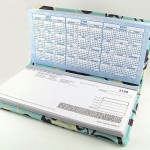A checkbook usually comes with checks, a number of deposit slips to deposit checks into your bank account, a section to mark deposits and withdrawals so you can balance your checkbook, and a sleeve for receipts. Some people carry a checkbook on them wherever they go in their purse or briefcase. Since a checkbook contains your banking information you should keep it in a safe place. You can lose money if you lose your checkbook and can’t get to your bank fast enough to report it.
 When a customer opens a checking account they’re given a set of starter checks. Once your starter checkbook runs out you’ll need to order a set of real checks through the bank.
When a customer opens a checking account they’re given a set of starter checks. Once your starter checkbook runs out you’ll need to order a set of real checks through the bank.
Some people will get checkbook covers with designs in order to personalize their checkbook. Checks contain certain information including your checking account number, your routing number, your bank’s name, and your contact information. Checks are also numbered, so you must continue with the sequence when you get new checks.
A checkbook also has a registry where you can balance your bank account. This is an important process because banks sometimes make mistakes which can cost you. Just yesterday my bank accidentally took out $200 more than a check I had written for. You can verify all your checks against your monthly banking statement. You can also view this information online if you do online banking. Balancing your checkbook also ensures that you don’t write checks for amounts that you don’t have in your checking account.
Learning how to maintain your checkbook is an important skill to have and should be taught as soon as possible. If you have a child you should teach them how to balance their checkbook when they open their first bank account.
